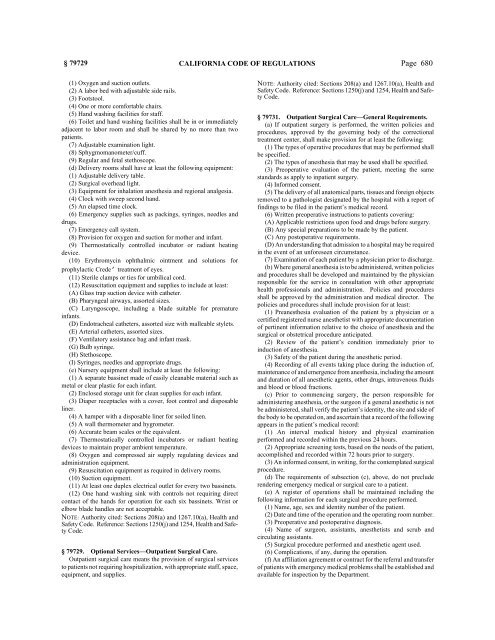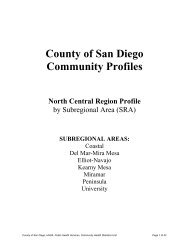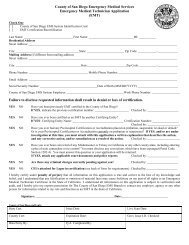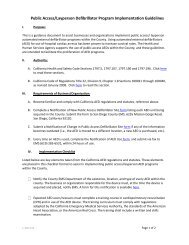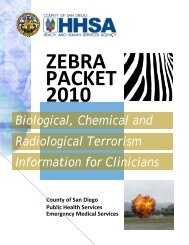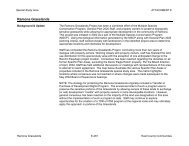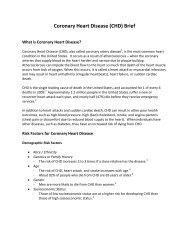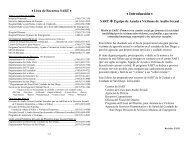CALIFORNIA CODE OF REGULATIONS - State of California
CALIFORNIA CODE OF REGULATIONS - State of California
CALIFORNIA CODE OF REGULATIONS - State of California
Create successful ePaper yourself
Turn your PDF publications into a flip-book with our unique Google optimized e-Paper software.
§ 79729 <strong>CALIFORNIA</strong> <strong>CODE</strong> <strong>OF</strong> <strong>REGULATIONS</strong><br />
Page 680<br />
(1) Oxygen and suction outlets.<br />
(2) A labor bed with adjustable side rails.<br />
(3) Footstool.<br />
(4) One or more comfortable chairs.<br />
(5) Hand washing facilities for staff.<br />
(6) Toilet and hand washing facilities shall be in or immediately<br />
adjacent to labor room and shall be shared by no more than two<br />
patients.<br />
(7) Adjustable examination light.<br />
(8) Sphygmomanometer/cuff.<br />
(9) Regular and fetal stethoscope.<br />
(d) Delivery rooms shall have at least the following equipment:<br />
(1) Adjustable delivery table.<br />
(2) Surgical overhead light.<br />
(3) Equipment for inhalation anesthesia and regional analgesia.<br />
(4) Clock with sweep second hand.<br />
(5) An elapsed time clock.<br />
(6) Emergency supplies such as packings, syringes, needles and<br />
drugs.<br />
(7) Emergency call system.<br />
(8) Provision for oxygen and suction for mother and infant.<br />
(9) Thermostatically controlled incubator or radiant heating<br />
device.<br />
(10) Erythromycin ophthalmic ointment and solutions for<br />
prophylactic Crede’ treatment <strong>of</strong> eyes.<br />
(11) Sterile clamps or ties for umbilical cord.<br />
(12) Resuscitation equipment and supplies to include at least:<br />
(A) Glass trap suction device with catheter.<br />
(B) Pharyngeal airways, assorted sizes.<br />
(C) Laryngoscope, including a blade suitable for premature<br />
infants.<br />
(D) Endotracheal catheters, assorted size with malleable stylets.<br />
(E) Arterial catheters, assorted sizes.<br />
(F) Ventilatory assistance bag and infant mask.<br />
(G) Bulb syringe.<br />
(H) Stethoscope.<br />
(I) Syringes, needles and appropriate drugs.<br />
(e) Nursery equipment shall include at least the following:<br />
(1) A separate bassinet made <strong>of</strong> easily cleanable material such as<br />
metal or clear plastic for each infant.<br />
(2) Enclosed storage unit for clean supplies for each infant.<br />
(3) Diaper receptacles with a cover, foot control and disposable<br />
liner.<br />
(4) A hamper with a disposable liner for soiled linen.<br />
(5) A wall thermometer and hygrometer.<br />
(6) Accurate beam scales or the equivalent.<br />
(7) Thermostatically controlled incubators or radiant heating<br />
devices to maintain proper ambient temperature.<br />
(8) Oxygen and compressed air supply regulating devices and<br />
administration equipment.<br />
(9) Resuscitation equipment as required in delivery rooms.<br />
(10) Suction equipment.<br />
(11) At least one duplex electrical outlet for every two bassinets.<br />
(12) One hand washing sink with controls not requiring direct<br />
contact <strong>of</strong> the hands for operation for each six bassinets. Wrist or<br />
elbow blade handles are not acceptable.<br />
NOTE: Authority cited: Sections 208(a) and 1267.10(a), Health and<br />
Safety Code. Reference: Sections 1250(j) and 1254, Health and Safety<br />
Code.<br />
§ 79729. Optional Services—Outpatient Surgical Care.<br />
Outpatient surgical care means the provision <strong>of</strong> surgical services<br />
to patients not requiring hospitalization, with appropriate staff, space,<br />
equipment, and supplies.<br />
NOTE: Authority cited: Sections 208(a) and 1267.10(a), Health and<br />
Safety Code. Reference: Sections 1250(j) and 1254, Health and Safety<br />
Code.<br />
§ 79731. Outpatient Surgical Care—General Requirements.<br />
(a) If outpatient surgery is performed, the written policies and<br />
procedures, approved by the governing body <strong>of</strong> the correctional<br />
treatment center, shall make provision for at least the following:<br />
(1) The types <strong>of</strong> operative procedures that may be performed shall<br />
be specified.<br />
(2) The types <strong>of</strong> anesthesia that may be used shall be specified.<br />
(3) Preoperative evaluation <strong>of</strong> the patient, meeting the same<br />
standards as apply to inpatient surgery.<br />
(4) Informed consent.<br />
(5) The delivery <strong>of</strong> all anatomical parts, tissues and foreign objects<br />
removed to a pathologist designated by the hospital with a report <strong>of</strong><br />
findings to be filed in the patient’s medical record.<br />
(6) Written preoperative instructions to patients covering:<br />
(A) Applicable restrictions upon food and drugs before surgery.<br />
(B) Any special preparations to be made by the patient.<br />
(C) Any postoperative requirements.<br />
(D) An understanding that admission to a hospital may be required<br />
in the event <strong>of</strong> an unforeseen circumstance.<br />
(7) Examination <strong>of</strong> each patient by a physician prior to discharge.<br />
(b) Where general anesthesia is to be administered, written policies<br />
and procedures shall be developed and maintained by the physician<br />
responsible for the service in consultation with other appropriate<br />
health pr<strong>of</strong>essionals and administration. Policies and procedures<br />
shall be approved by the administration and medical director. The<br />
policies and procedures shall include provision for at least:<br />
(1) Preanesthesia evaluation <strong>of</strong> the patient by a physician or a<br />
certified registered nurse anesthetist with appropriate documentation<br />
<strong>of</strong> pertinent information relative to the choice <strong>of</strong> anesthesia and the<br />
surgical or obstetrical procedure anticipated.<br />
(2) Review <strong>of</strong> the patient’s condition immediately prior to<br />
induction <strong>of</strong> anesthesia.<br />
(3) Safety <strong>of</strong> the patient during the anesthetic period.<br />
(4) Recording <strong>of</strong> all events taking place during the induction <strong>of</strong>,<br />
maintenance <strong>of</strong> and emergence from anesthesia, including the amount<br />
and duration <strong>of</strong> all anesthetic agents, other drugs, intravenous fluids<br />
and blood or blood fractions.<br />
(c) Prior to commencing surgery, the person responsible for<br />
administering anesthesia, or the surgeon if a general anesthetic is not<br />
be administered, shall verify the patient’s identity, the site and side <strong>of</strong><br />
the body to be operated on, and ascertain that a record <strong>of</strong> the following<br />
appears in the patient’s medical record:<br />
(1) An interval medical history and physical examination<br />
performed and recorded within the previous 24 hours.<br />
(2) Appropriate screening tests, based on the needs <strong>of</strong> the patient,<br />
accomplished and recorded within 72 hours prior to surgery.<br />
(3) An informed consent, in writing, for the contemplated surgical<br />
procedure.<br />
(d) The requirements <strong>of</strong> subsection (c), above, do not preclude<br />
rendering emergency medical or surgical care to a patient.<br />
(e) A register <strong>of</strong> operations shall be maintained including the<br />
following information for each surgical procedure performed.<br />
(1) Name, age, sex and identity number <strong>of</strong> the patient.<br />
(2) Date and time <strong>of</strong> the operation and the operating room number.<br />
(3) Preoperative and postoperative diagnosis.<br />
(4) Name <strong>of</strong> surgeon, assistants, anesthetists and scrub and<br />
circulating assistants.<br />
(5) Surgical procedure performed and anesthetic agent used.<br />
(6) Complications, if any, during the operation.<br />
(f) An affiliation agreement or contract for the referral and transfer<br />
<strong>of</strong> patients with emergency medical problems shall be established and<br />
available for inspection by the Department.


